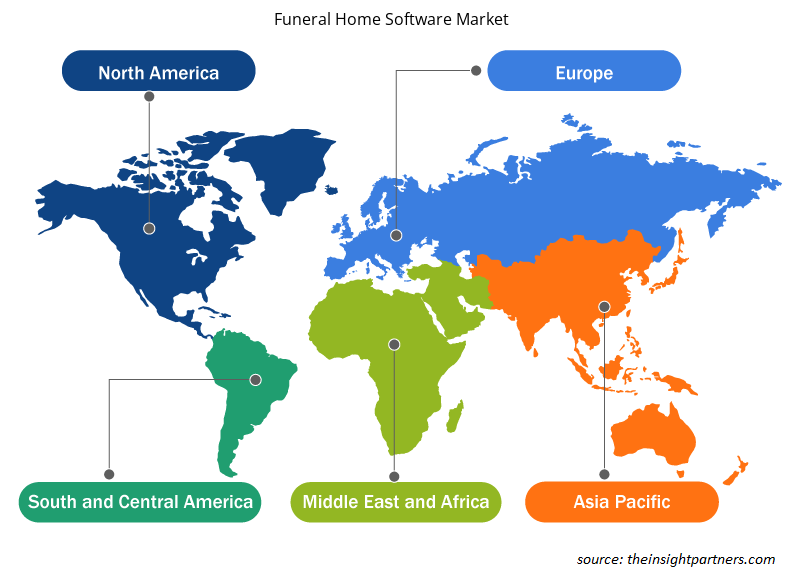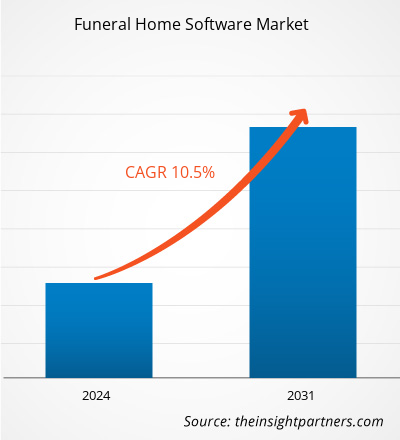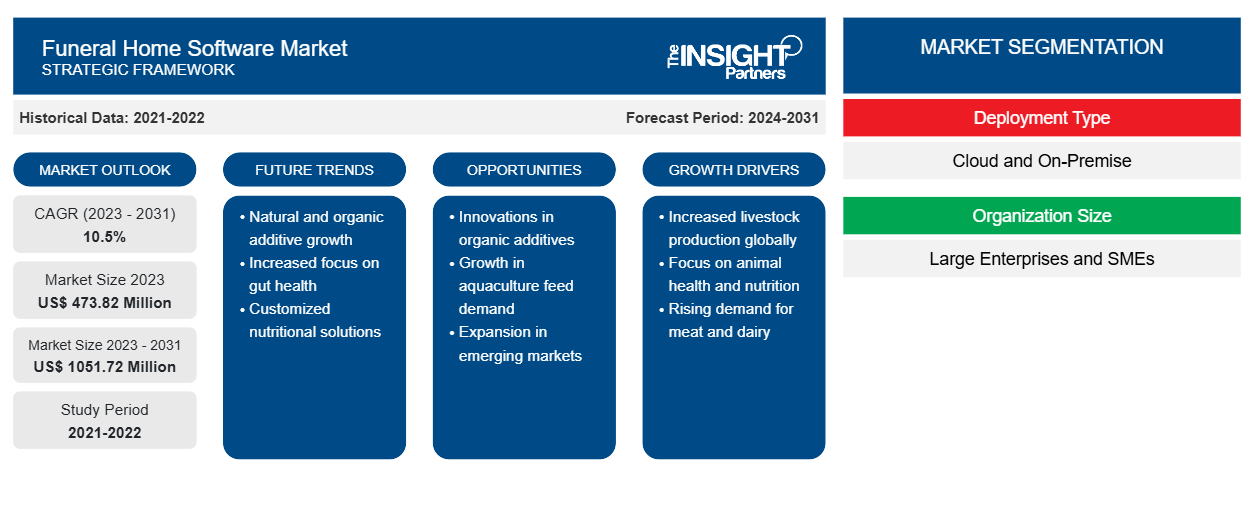Le marché des logiciels pour pompes funèbres devrait atteindre 1 051,72 millions de dollars américains d'ici 2031, contre 473,82 millions de dollars américains en 2023. Le marché devrait enregistrer un TCAC de 10,5 % en 2023-2031. La croissance de la numérisation et les avantages offerts par les logiciels pour pompes funèbres devraient rester les principales tendances du marché des logiciels pour pompes funèbres.
Analyse du marché des logiciels pour pompes funèbres
L’augmentation du nombre de décès entraîne une croissance du marché. La numérisation des opérations commerciales dans le monde entier a gagné du terrain, ce qui a conduit à l’adoption de solutions logicielles pour pompes funèbres. Les avantages offerts par les logiciels pour pompes funèbres, tels que la gestion facile des documents, l’amélioration du service client, la comptabilité automatisée et d’autres, favorisent la demande des pompes funèbres pour des opérations plus rapides et plus efficaces. Les exploitants et les gestionnaires de pompes funèbres peuvent organiser des funérailles et interagir avec les clients à l’aide d’un logiciel pour pompes funèbres. Les exploitants de pompes funèbres peuvent utiliser des solutions logicielles pour gérer la planification, les ressources et les services personnalisés. Souvent, le programme propose un portail où les clients peuvent soumettre des demandes de service et partager des informations sur le défunt.
Aperçu du marché des logiciels pour pompes funèbres
Les logiciels pour pompes funèbres aident les pompes funèbres, les morgues et les crématoriums à gérer et à gérer tous les aspects des opérations quotidiennes. Il automatise la comptabilité, l'inventaire et la gestion des documents. Les logiciels pour pompes funèbres offrent un contrôle complet sur les tâches administratives. Les fonctionnalités du front-office vous permettent de gérer les services funéraires, de partager et de signer des documents, ainsi que de partager des marchandises et des monuments commémoratifs sur le site Web ou sur les réseaux sociaux.
Personnalisez ce rapport en fonction de vos besoins
Vous bénéficierez d'une personnalisation gratuite de n'importe quel rapport, y compris de certaines parties de ce rapport, d'une analyse au niveau des pays, d'un pack de données Excel, ainsi que d'offres et de remises exceptionnelles pour les start-ups et les universités.
-
Obtenez les principales tendances clés du marché de ce rapport.Cet échantillon GRATUIT comprendra une analyse de données, allant des tendances du marché aux estimations et prévisions.
Moteurs et opportunités du marché des logiciels pour pompes funèbres
La numérisation au service du marché
La numérisation est en plein essor dans le monde entier. La numérisation transforme le modèle commercial, les opérations et l'expérience client. Ainsi, la numérisation dans le secteur funéraire contribue à automatiser le processus funéraire. La numérisation des pompes funèbres apporte de l'efficacité dans toute la gestion des pompes funèbres. Grâce à un logiciel, les clients peuvent signer numériquement les documents requis sans avoir à être physiquement présents. Un logiciel de pompes funèbres aide les prestataires de services de pompes funèbres à organiser l'accueil, les heures de livraison, les horaires de service et les invitations. Cela facilite une expérience positive pour leurs clients pendant une période difficile. Les documents, tels que les certificats commémoratifs ou les certificats de décès, peuvent être importés et stockés numériquement. Ces plateformes offrent des ressources pour archiver les données sur les arrangements funéraires et les défunts. Avec l'aide d'un logiciel de pompes funèbres, l'exploitant de pompes funèbres peut aider les utilisateurs à planifier les services à venir et à établir un enregistrement des services passés. Beaucoup ont les moyens d'acheter des fleurs, des photos et d'autres éléments personnalisés pour les services. Quelques-uns sont également dotés d'outils permettant de vérifier les registres funéraires. Des rapports peuvent être créés par plusieurs logiciels funéraires et soumis à des logiciels de gestion de base de données ou de comptabilité.
Hausse du nombre de décès dans le monde – Une opportunité sur le marché des logiciels pour pompes funèbres
Avec l’évolution des modes de vie et des habitudes alimentaires, on assiste à une augmentation des maladies cardiovasculaires (MCV) dans le monde entier. Des facteurs tels que la pollution de l’air, l’hypertension artérielle, le tabagisme et l’hypercholestérolémie sont quelques-uns des facteurs à l’origine de l’augmentation du nombre de décès. Par exemple, selon la Fédération mondiale du cœur (WHF), les décès dus aux maladies cardiovasculaires sont passés de 12,1 millions en 1990 à 20,5 millions en 2021 à l’échelle mondiale. Le World Heart Report a été lancé lors du World Heart Summit de 2023. Ainsi, l’augmentation des décès dus à des raisons spécifiques a conduit à une augmentation des opérations dans les pompes funèbres. L’adoption d’un logiciel pour pompes funèbres aidera les prestataires de services de pompes funèbres à gérer efficacement les opérations funéraires. Ainsi, l’augmentation des décès constitue une opportunité de croissance du marché car elle encouragera le prestataire de services de pompes funèbres à adopter des solutions pour gérer efficacement le processus et la documentation.
Analyse de segmentation du rapport sur le marché des logiciels pour pompes funèbres
Les segments clés qui ont contribué à l’élaboration de l’analyse du marché des logiciels pour pompes funèbres sont le type de produit et l’application.
- En fonction des composants, le marché est divisé en logiciels et services. Le segment des logiciels détenait une part de marché plus importante en 2023.
- En termes de déploiement, le marché est segmenté en cloud et sur site. Le segment sur site détenait la plus grande part du marché en 2023.
- En fonction de la taille de l'entreprise, le marché est segmenté en PME et en grandes entreprises. Le segment des grandes entreprises détenait la plus grande part du marché en 2023.
Analyse des parts de marché des logiciels pour pompes funèbres par zone géographique
La portée géographique du rapport sur le marché des logiciels de pompes funèbres est principalement divisée en cinq régions : Amérique du Nord, Asie-Pacifique, Europe, Moyen-Orient et Afrique, et Amérique du Sud/Amérique du Sud et centrale.
En termes de chiffre d'affaires, l'Amérique du Nord représente la plus grande part de marché des logiciels pour pompes funèbres. Les États-Unis, le Canada et le Mexique figurent parmi les principaux pays d'Amérique du Nord. La région est l'un des premiers à adopter des solutions technologiquement avancées, ce qui est l'un des principaux facteurs de croissance du marché. Les acteurs du marché des logiciels pour pompes funèbres de la région, parmi lesquels Aldor Solutions, FuneralTech, Lytesoft et bien d'autres, favorisent la part de marché de la région.
Aperçu régional du marché des logiciels pour pompes funèbres
Les tendances et facteurs régionaux influençant le marché des logiciels pour pompes funèbres tout au long de la période de prévision ont été expliqués en détail par les analystes d’Insight Partners. Cette section traite également des segments et de la géographie du marché des logiciels pour pompes funèbres en Amérique du Nord, en Europe, en Asie-Pacifique, au Moyen-Orient et en Afrique, ainsi qu’en Amérique du Sud et en Amérique centrale.

- Obtenez les données régionales spécifiques au marché des logiciels pour pompes funèbres
Portée du rapport sur le marché des logiciels pour pompes funèbres
| Attribut de rapport | Détails |
|---|---|
| Taille du marché en 2023 | 473,82 millions de dollars américains |
| Taille du marché d'ici 2031 | 1 051,72 millions de dollars américains |
| Taux de croissance annuel composé mondial (2023-2031) | 10,5% |
| Données historiques | 2021-2022 |
| Période de prévision | 2024-2031 |
| Segments couverts |
Par type de déploiement
|
| Régions et pays couverts |
Amérique du Nord
|
| Leaders du marché et profils d'entreprises clés |
|
Densité des acteurs du marché des logiciels pour pompes funèbres : comprendre son impact sur la dynamique commerciale
Le marché des logiciels pour pompes funèbres connaît une croissance rapide, tirée par la demande croissante des utilisateurs finaux en raison de facteurs tels que l'évolution des préférences des consommateurs, les avancées technologiques et une plus grande sensibilisation aux avantages du produit. À mesure que la demande augmente, les entreprises élargissent leurs offres, innovent pour répondre aux besoins des consommateurs et capitalisent sur les tendances émergentes, ce qui alimente davantage la croissance du marché.
La densité des acteurs du marché fait référence à la répartition des entreprises ou des sociétés opérant sur un marché ou un secteur particulier. Elle indique le nombre de concurrents (acteurs du marché) présents sur un marché donné par rapport à sa taille ou à sa valeur marchande totale.
Les principales entreprises opérant sur le marché des logiciels pour pompes funèbres sont :
- N / A
Avis de non-responsabilité : les sociétés répertoriées ci-dessus ne sont pas classées dans un ordre particulier.

- Obtenez un aperçu des principaux acteurs du marché des logiciels pour pompes funèbres
Actualités et développements récents du marché des logiciels pour pompes funèbres
Le marché des logiciels pour pompes funèbres est évalué en collectant des données qualitatives et quantitatives issues de recherches primaires et secondaires, qui comprennent d'importantes publications d'entreprise, des données d'associations et des bases de données. Voici une liste des évolutions du marché :
- En mars 2022, CTV Software Pty Ltd. a annoncé Funeral Buddy 6.0 avec de nouvelles fonctionnalités. Ses nouvelles fonctionnalités pour les succursales, l'accès familial et d'autres améliorations améliorent la gestion globale des pompes funèbres. Grâce à cette fonctionnalité supplémentaire, la famille obtient des identifiants de connexion et a un accès rapide aux documents de transfert. (Source : CTV Software Pty Ltd., Communiqué de presse, 2022)
- En mars 2023, Strategic Funeral Resources (SFR) a lancé quatre programmes de publicité sur les réseaux sociaux à prix raisonnable pour aider les prestataires de services funéraires à accroître l'engagement des consommateurs et à accroître leur rentabilité. Chaque programme est disponible dans l'un des deux forfaits (standard et préféré), et bon nombre d'entre eux offrent des fonctionnalités de personnalisation exceptionnelles. Les forfaits intègrent son logiciel d'intelligence artificielle exclusif Automated Virtual Arranger (AVA). En numérisant le propriétaire de la maison funéraire ou un membre du personnel, le processus AVA prend les meilleurs types d'interactions humaines - des connexions engageantes, chaleureuses et émotionnelles - et les combine avec une technologie d'IA révolutionnaire pour créer une expérience de visualisation de contenu réaliste pour le public cible d'une entreprise. (Source : National Funeral Directors Association, communiqué de presse, 2023)
Rapport sur le marché des logiciels pour pompes funèbres et livrables
Le rapport « Taille et prévisions du marché des logiciels pour pompes funèbres (2021-2031) » fournit une analyse détaillée du marché couvrant les domaines ci-dessous :
- Taille du marché et prévisions aux niveaux mondial, régional et national pour tous les segments de marché clés couverts par le périmètre
- Dynamique du marché, comme les facteurs moteurs, les contraintes et les opportunités clés
- Principales tendances futures
- Analyse détaillée des cinq forces de PEST/Porter et SWOT
- Analyse du marché mondial et régional couvrant les principales tendances du marché, les principaux acteurs, les réglementations et les développements récents du marché
- Analyse du paysage industriel et de la concurrence couvrant la concentration du marché, l'analyse de la carte thermique, les principaux acteurs et les développements récents
- Profils d'entreprise détaillés
- Analyse historique (2 ans), année de base, prévision (7 ans) avec TCAC
- Analyse PEST et SWOT
- Taille du marché Valeur / Volume - Mondial, Régional, Pays
- Industrie et paysage concurrentiel
- Ensemble de données Excel
Rapports récents
Rapports connexes
Témoignages
Raison d'acheter
- Prise de décision éclairée
- Compréhension de la dynamique du marché
- Analyse concurrentielle
- Connaissances clients
- Prévisions de marché
- Atténuation des risques
- Planification stratégique
- Justification des investissements
- Identification des marchés émergents
- Amélioration des stratégies marketing
- Amélioration de l'efficacité opérationnelle
- Alignement sur les tendances réglementaires























 Obtenez un échantillon gratuit pour - Marché des logiciels pour pompes funèbres
Obtenez un échantillon gratuit pour - Marché des logiciels pour pompes funèbres